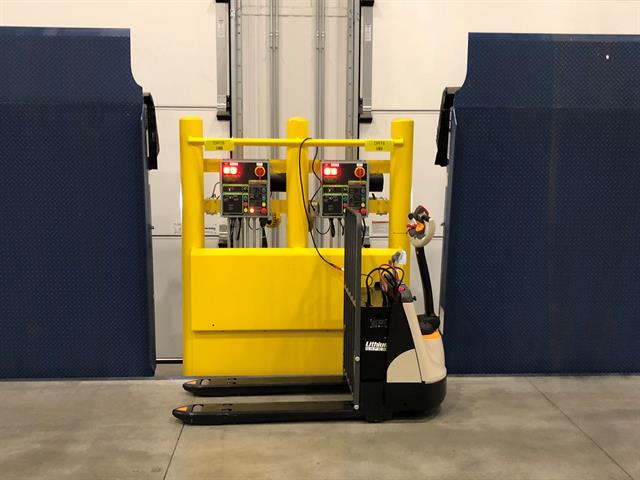 VanZwol |
Jeffrey VanZwol is chief marketing officer with Green Cubes Technology, a developer and manufacturer of lithium power systems.
Opportunity charging is a practice applicable to both lead acid and lithium-ion (Li-ion) batteries for motive power systems and especially useful for materials handling equipment. These practices can be applied to all classes of handling equipment - from small pallet jacks to four-wheel forklifts and large turret trucks.
Charging lead acid batteriesDifferent lead acid battery types are available for motive power including the Thin Pure Plate Lead (TPPL), Absorbed Glass Matt (AGM) and the widely used, most common Flooded Lead Acid (FLA). For optimal cycle and calendar life of FLA batteries, manufacturers recommend that the daily cycle for batteries consist of:
1) using and discharging the batteries, typically over an eight-hour shift;
2) 8-10 hours of conventional charging at a C/5 rate (i.e. ~20 Amps per every 100 Amp-Hours);
3) resting for an eight-hour cool-down period.
Additionally, it is critical to equalise the battery on a weekly basis: charging the battery to 100% state of charge and reducing the build-up of sulphates. This conventional charge/discharge regimen is reinforced by FLA battery manufacturers through their warranties; thus each battery experiences one full charge and discharge cycle per day. Note that FLA batteries can be opportunity charged (typically 25 Amps per 100 Amp-Hour or C/4 rate) and fast charged (typically up to 50 Amps per 100 Amp-Hour or C/2 rate), but these unconventional FLA charge regimens shorten or violate the manufacturer warranties.
If an enterprise follows guidelines from the manufacturer, then they can expect to receive 500-1,000 cycles from their FLA batteries before they start to experience permanent capacity fade. The implication of this recommended charge regimen is that equipment used on a single shift may need one or two batteries for each vehicle. If the enterprise operates a multi-shift operation, then more than one battery is definitely required per vehicle. So, at a minimum, multi-shift operations dictate a battery swap when the shift changes.
Charging Li-ion batteriesLi-ion batteries are preferably charged using a constant current/constant voltage (CC/CV) charge regimen, but most materials handling equipment batteries are designed to accept both CC/CV and FLA charge regimens. One common characteristic of all Li-ion batteries is that, regardless of the state of charge of the battery when connected to the charger, the battery will efficiently accept the power and increase its state of charge. Whether the battery has been connected to the charger for 15 minutes or two hours, that battery can be immediately discharged and used by the equipment as there is no need to cool or rest a Li-ion battery after charging.
The Li-ion cell chemistry has numerous chemical variants. Lithium Iron Phosphate (LFP) chemistry is the predominant chemistry used to power materials handling equipment. LFP chemistry is differentiated from its Li-ion cousins on several dimensions, including:
1) exceptionally long cycle life (2,000 - 4,000 cycles to reach 80% of the original capacity);
2) high power capabilities for both charge and discharge;
3) lower energy/density than other Li-ion variants.
 Determine whether there are opportunities for ad hoc or scheduled charging |
The long cycle life means an LFP battery can be installed and remain in the equipment until it is retired (i.e. no battery swaps for the equipment life). More importantly, since LFP chemistry can accommodate high power delivered to and from the battery, a depleted LFP battery can accept a full charge in one hour. This charge does not need to be delivered in one charging session. Rather, it can be delivered throughout the shift when the operator has down-time (for example, a break or lunch). Since LFP batteries can accept partial charges between use and a depleted battery can be charged within one hour, Li-ion is the optimal chemistry for opportunity charging.
Beyond opportunity charging, some secondary benefits of adopting Li-ion batteries to power your fleet include the release of warehouse floor space, the elimination of battery handling and changing equipment, and the reduction of personnel affiliated with the charging process. Additionally, operators can eliminate the cross-area travel time from their normal work areas to the battery room to change out batteries. Finally, the potentially hazardous task of swapping heavy batteries is not necessary, thus minimising employee injuries.
Best practices to exploit opportunity chargingListed below are the guidelines that Green Cubes Technology has developed to assist our customers in maximising their return on investment in Li-ion batteries and charging infrastructure. Opportunity charging has a multiplier effect on the positive return for adopting Li-ion batteries.
1. Understand the existing operational workflow of the operators/equipment/batteries to assess the available time per shift to connect to a charger. This can be established through a power study where the operator/equipment/battery activity is monitored for up to four weeks, and worst-case usage models should not be ignored. Based on the data, one can determine whether there are adequate opportunities for ad hoc (eg. coffee break) or scheduled (eg. lunch) charging throughout the shift. If there is no down-time for the equipment throughout the shift, then the batteries will need to be charged for an hour before the shift. Or, the operator's existing work flow can be modified so that there is some down-time made available for opportunity charging the equipment.
2. Single-shift vs. multi-shift operations can determine the value of opportunity charging for an enterprise. If the enterprise operates a single-shift operation, a fully charged Li-ion (or FLA) battery should power that vehicle through the shift. However, when a second (or third) shift is needed, then opportunity charging can be used to recharge that integrated battery in increments and ensure that the equipment is powered through all the shifts.
3. Rather than charging FLA batteries in a centralised battery maintenance room, the enterprise can distribute the Li-ion charging stations near break rooms and heavy work areas. This will encourage and enable operators to charge their equipment when the operators have down-time or are not using their equipment. Decentralised charging stations eliminate the operators' travel time from their work area to the battery maintenance room as well.
4. Assess existing FLA chargers to determine if they are compatible with the Li-ion batteries. There are some charging parameters, such as voltage limits, that need to be aligned between the battery and charger. But most FLA chargers are typically compatible with Li-Ion batteries, enabling the use of the existing charging infrastructure for opportunity charging.
5. Assess the power output of the existing FLA and Li-ion charging infrastructure. As mentioned earlier, the conventional FLA battery charge regimen is a C/5 rate over an eight-hour period. With opportunity charging, the Li-ion battery should be charged throughout the shift at a 1 C rate for a total accumulated time of one hour. The implication is the power rating on the charger must be much higher when opportunity charging. As an example, a 48 Volt 500 Amp-Hour FLA battery could be charged with a 5 kW charger over an eight hour period, while a similarly-sized Li-ion battery would require a 25 kW charger for a one hour period.
6. Consider a multi-voltage battery if opportunity charging is desired but there is not adequate down-time within a shift. A multi-voltage battery has a power switching fabric within the battery electronics. The charger's charge voltage is set at twice the equipment's operating voltage, and the battery electronics then steps down the received power to the equipment's operating voltage. The charger delivers twice the amount of power when charging at twice the voltage, therefore the charge time is reduced by 50%. Multi-voltage battery options are available in 24 v (24/48), 36 v (36/72) and 48 v (48/96) battery configurations.
7. Consider the equipment/charger ratio. The best case for operators is a 1:1 ratio, so all operators can take their lunch together and each piece of equipment can be charged during this down-time. If the enterprise can stagger coffee/lunch breaks or run the fleet between 50-100% utilisation, then they can reduce this ratio down to 2:1 and still ensure that all equipment has unfettered access to the local charger.
8. Assess your operators' behaviour after you have introduced opportunity charging. Some Li-ion batteries have embedded Internet of Things (IoT) computing, WiFi transceivers and cloud-based applications so the enterprise can remotely monitor their operators' adoption and effectiveness with opportunity charging. One simple measure is monitoring the state of charge of each piece of equipment/battery throughout the day. Any operators/equipment consistently operating in the 5-20% state of charge range may need some retraining on opportunity charging.
SummaryLi-ion batteries, combined with opportunity charging, enable an enterprise to operate their fleet without productivity loss affiliated with charging or swapping batteries. Opportunity charging can increase the velocity of your business and improve the utilisation of your MH equipment fleet. Secondary benefits include the reuse of warehouse floor space allocated to battery rooms, the elimination of FLA battery handling and changing equipment, and the equipment's travel time to the battery room to swap batteries.